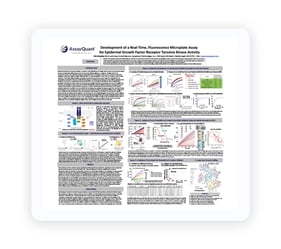A Continuous Fluorescence Microplate Assay for Epidermal Growth Factor Receptor (EGFR) Wild-Type and Mutant Tyrosine Kinase Activity
This poster dives into our team's development of a continuous, real-time, fluorescence-based assay for EGFR tyrosine kinase inhibitors (TKI’s).
As a member of the ErbB/HER protein family, the human epidermal growth factor receptor (EGFR) includes four structurally related receptor tyrosine kinase (RTK) enzymes that are activated by different ligands. The binding of EGF to the extracellular domain of the EGFR RTK results in autophosphorylation of the dimer, which activates a series of downstream signaling cascades that regulate multiple cellular functions. When deregulated, it is one of the most frequent causes of solid tumors2. This family of ligand-binding, activatable, receptor-based enzymes are active targets for research and drug discovery3, particularly in combination with other small molecule drugs or antibody-based therapies4.
The efficacy of a particular kinase inhibitor, when combined with a particular monoclonal antibody or another small molecule drug, is highly dependent on the mechanism of the inhibitor. Therefore, tyrosine kinase activity assays enable the identification of diverse inhibitor properties, allowing profiling and ranking of lead candidates early in the discovery process. They are likely to be more fruitful for developing combined therapeutic approaches due to the careful characterization of structural variants during candidate optimization.
Below we describe our development of a continuous, real-time, fluorescence-based assay for EGFR tyrosine kinase inhibitors using PhosphoSens® Technology to provide critical kinetic data necessary for the detailed characterization and ranking of lead candidates. Designed for use with a simple add-and-read workflow and standard fluorescence microplate reader, PhosphoSens Technology is both novel and non-disruptive, delivering a progress curve in every well. Our continuous assay format can readily distinguish covalent from reversible inhibitors based on residence time, following our Time-Dependent Inhibition (TDI) workflow. While being highly reproducible and easy to use, our methodology works with wild-type (natural) EGFR and a panel of clinically-relevant mutants. In addition to our continuous, kinetic format, we developed a partner end-point assay, PhosphoSens-Red, to allow for the structural optimization of lead candidates in high-throughput mode, even for highly auto-fluorescent compounds.
Development of a Real-Time, Fluorescence Microplate Assay for Epidermal Growth Factor Receptor (EGFR) Tyrosine Kinase Activity
Highlights From The Poster Include:
- An overview of AssayQuant’s kinetic and end-point assay formats:
- PhosphoSens-Kinetic (continuous)
- PhosphoSens-Red (end-point)
- EGFR sensor peptide substrate and assay development/optimization
- Systematic development of CSox sensor peptide using iterative learning cycles
- Determination of enzyme linearity, ATP Km and sensor peptide Km
- Application of the optimized EGFR PhosphoSens assay to characterize reversible, time-dependent and covalent inhibitors for wild-type and mutant EGFRs;
- IC50 analysis of a reversible inhibitor
- Residence time and koff for reversible and covalent inhibitors
- kinact/KI determination for covalent inhibitors
- Application of the optimized EGFR PhosphoSens assay to conduct full kinome panel compound profiling

Download Poster
♦ IC50, EC50 and Ki for catalytic inhibitor/activator potency ♦ Kinome Profiling for compound selectivity ♦ Progress Curve Analysis for time-dependent inhibition ♦ Jump Dilution for reversible vs irreversible determinations ♦ Residence Time for reversible inhibition studies ♦ kinact/KI for irreversible inhibition studies ♦ MOI/MOA for inhibitor-substrate competition studies ♦ Add Eu3+ for red-shifted endpoint HTS ♦
VIDEO
Want To Learn More About The Science and Technology Behind PhosphoSens?
AssayQuant's President, CSO and CEO, Dr. Erik Schaefer, guides you through the science of PhosphoSens Technology in his presentation:
Leveraging Continuous Fluorogenic Assays for Kinase & Phosphatase Activity to Enable Drug Development
PhosphoSens Technology is novel and non-disruptive – delivering a progress curve in every well using a simple add-and-read workflow and standard fluorescence microplate reader. PhosphoSens kinetic assays yield rich datasets from one technology, making them an ideal successor to platforms like mobility shift and radioactive assays.
AssayQuant's kinetic assays are continuous by design enabling direct detection and quantification of kinase activity. Each assay is optimized using our proprietary CSox fluorophore covalently bound to a physiologically derived peptide substrate. For end-point format, add europium to the kinetic assay at any point during the progress curve to yield a red-shifted, time-resolved assay to enable correction for compound auto-fluorescence and batch mode processing for high throughput applications.

Erik Schaefer, Ph.D., President, CEO and CSO
Erik has over 25 years of experience at leading Life Science tool companies, including Promega, Invitrogen/Life Technologies, EMD-Merck-Millipore and Thermo Fisher Scientific, where he integrated innovative technologies to accelerate discovery and drug development. His expertise is in elucidating the role of protein kinases and phosphatases in normal and disease states and building workflow solutions to enable these efforts.